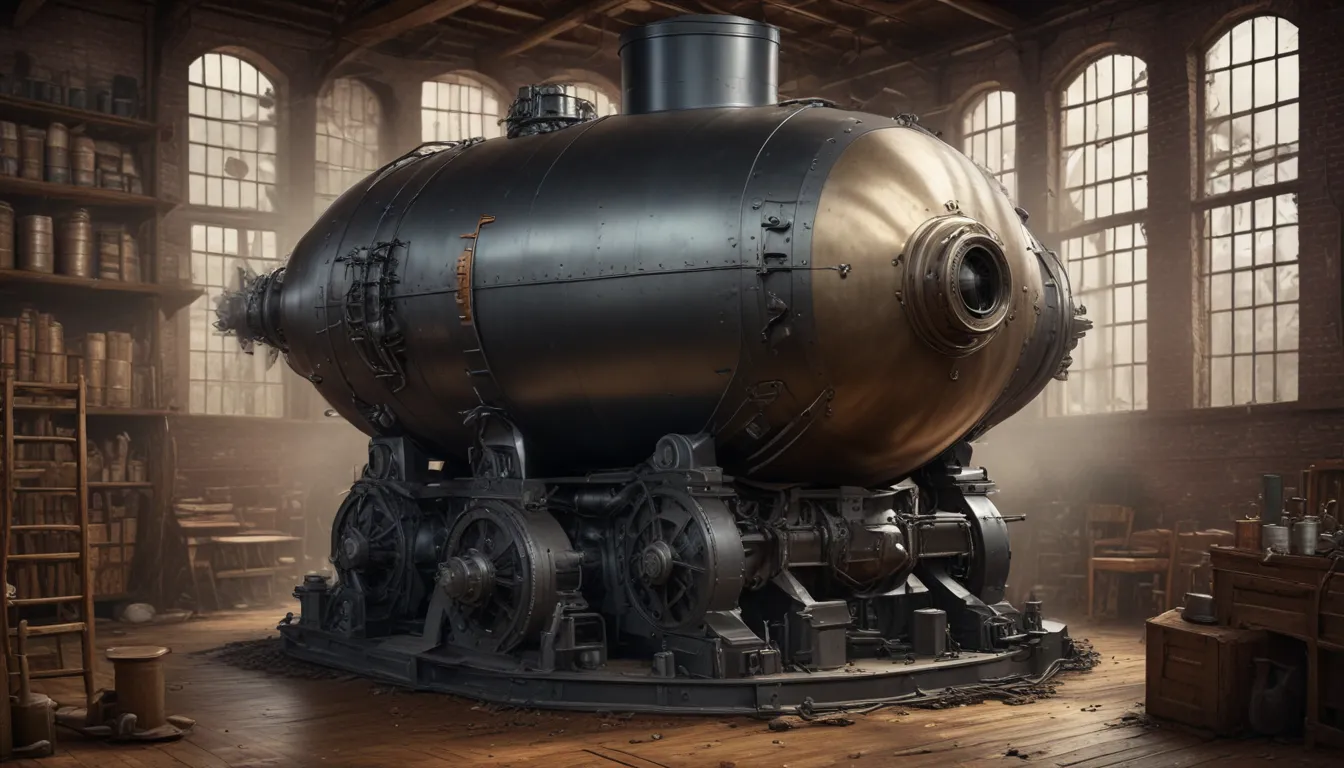A Note About Images: The images used in our articles are for illustration purposes only and may not exactly match the content. They are meant to engage readers, but the text should be relied upon for accurate information.
In the realm of industrial history, the Bessemer process stands as a pivotal innovation that reshaped steel production during the 19th century. Developed by the ingenious Sir Henry Bessemer, this progressive method transformed the landscape of modern manufacturing by converting iron into steel through oxidation. As we embark on this enlightening journey, we will unravel 10 captivating facts about the Bessemer process, illuminating its significance and profound impact on the industrial revolution. From its modest beginnings to its far-reaching implications, these facts will showcase the ingenuity and transformative power of this pioneering steel-making technique.
Key Takeaways:
- The Bessemer Process revolutionized steel production, making it faster, cheaper, and stronger. This led to the construction of railways, skyscrapers, and ships, shaping the modern world we live in today.
- Sir Henry Bessemer’s innovative technique removed impurities from molten iron, making steel more affordable and accessible. This transformed society, fueling industrial growth and changing the way we build and manufacture.
Reimagining Steel Production: The Bessemer Process
The Bessemer Process, forged by the visionary Sir Henry Bessemer in the 19th century, marked a significant breakthrough in steel production. This innovative technique paved the way for the mass production of high-quality steel, heralding a new era in industrial history.
Origins Named After Genius: Sir Henry Bessemer
The Bessemer Process owes its moniker to its creator, Sir Henry Bessemer, an English engineer and inventor who pioneered this transformative method. By introducing air into molten iron, he successfully eliminated impurities and fostered the creation of steel.
A Catalyst for Industrial Growth: Bessemer Process in Action
The introduction of the Bessemer Process heralded a paradigm shift in the industrial landscape, drastically reducing both the cost and time associated with steel production. This catalytic acceleration in industrial growth fueled advancements in construction, transportation, and manufacturing sectors, playing a pivotal role in societal development.
Elevating Steel Quality: Strength Redefined
The Bessemer Process ushered in a new era of steel quality by effectively eliminating impurities, including excess carbon and sulfur. This refining process resulted in a stronger and more durable material that proved instrumental in erecting railway tracks, bridges, and buildings that defined urban landscapes.
Accessible Innovation: Making Steel Affordable
Before the advent of the Bessemer Process, steel was a precious and scarce commodity, reserved mainly for luxury items. However, this trailblazing process revolutionized the cost of steel production, making it more accessible to a broad array of industries and consumers.
Driving the Industrial Revolution: Bessemer’s Impact
The Bessemer Process played a pivotal role in the Industrial Revolution by offering a scalable and cost-efficient means of producing steel. This groundbreaking development paved the way for the construction of railways, skyscrapers, and machinery, fueling the swift modernization of global societies.
Innovation Reforged: The Evolution of Bessemer Process
While the original Bessemer Process had its limitations, it served as a springboard for subsequent advancements in steel production. Engineers and inventors refined this process, giving rise to innovations like the Basic Oxygen Process that built upon Bessemer’s foundational concept.
Nautical Transformation: Bessemer’s Influence on Shipbuilding
The Bessemer Process left an indelible mark on the shipbuilding industry, enabling the construction of larger and sturdier vessels. The newfound availability of affordable steel propelled advancements in naval architecture, revolutionizing global trade and maritime exploration.
Steel: The Backbone of Modern Infrastructure
With the widespread adoption of the Bessemer Process, steel emerged as the cornerstone of modern infrastructure. From bridges and buildings to machinery and vehicles, the strength, versatility, and affordability of steel rendered it indispensable in shaping our contemporary world.
Societal Metamorphosis: Bessemer Process’s Impact
The transformative influence of the Bessemer Process on society transcends mere accolades. It ignited industrialization, spurred economic growth, and reshaped the very fabric of construction and manufacturing. The ubiquity and utilization of steel reshaped societies, representing one of the most pivotal advancements in history.
Embracing the Legacy: Bessemer Process Today
The legacy of the Bessemer Process endures, resonating in myriad applications worldwide. From towering skyscrapers to sleek automobiles, from resilient bridges to intricate machinery, steel produced through the Bessemer Process continues to fashion our modern society. It stands as a testament to human ingenuity and underscores the profound impact of scientific innovations on progress.
FAQs on the Bessemer Process
- What is the Bessemer Process?
-
The Bessemer Process was a steel-making technique developed by Sir Henry Bessemer in the 19th century, involving the introduction of air into molten iron to produce high-quality steel.
-
How did the Bessemer Process revolutionize the steel industry?
-
By enabling the mass production of high-quality steel at a reduced cost, the Bessemer Process superseded traditional labor-intensive methods, making steel more accessible and affordable across various applications.
-
What are the advantages of the Bessemer Process?
-
The Bessemer Process boasts several advantages, such as rapid steel production, cost-effectiveness compared to traditional methods, and the creation of durable, versatile steel of superior quality.
-
Significant Applications of Bessemer Steel
-
Steel produced through the Bessemer Process finds widespread use in diverse industries, including construction, infrastructure, transportation, and manufacturing sectors.
-
Is the Bessemer Process still in use today?
-
Although modern steel-making techniques have supplanted the Bessemer Process, its historical significance remains palpable. Many historical structures and artifacts bear the imprint of steel produced through this pioneering method, underscoring its enduring impact.
-
Who is Sir Henry Bessemer?
- Sir Henry Bessemer, an English inventor and engineer, revolutionized the steel industry with his groundbreaking Bessemer Process. His innovation played a vital role in the Industrial Revolution, reshaping the course of history.
Embark on a Quest for Knowledge
Unveiling the Bessemer Process is merely the tip of the iceberg when it comes to understanding the raw materials and processes shaping our world. Explore the captivating domain of iron ore, the indispensable ingredient in steel-making, unraveling its profound role in industrial evolution. Delve into the ancient practice of metallurgy, an art and science cultivating metals for millennia, offering insights into our transformative journey. And don’t overlook the steam engines that galvanized the Industrial Revolution, synergizing with Bessemer’s innovation to redefine historical trajectories. Each topic paves the way for a rich tapestry of knowledge waiting to be unearthed.
Join Our Journey
Our commitment to delivering authentic and engaging content resonates at the core of our mission. Every fact shared on our platform is a testament to contributions from real users like yourself, enriching our collective pool of diverse insights and information. As we strive for excellence, our dedicated editors meticulously review each submission, ensuring precision, credibility, and reliability in all our shared facts. Trust in our dedication to quality and authenticity as you embark on a journey of exploration and learning with us.
As you seek to broaden your horizons and deepen your understanding of transformative innovations like the Bessemer Process, let curiosity be your guide and knowledge your compass in navigating the rich tapestry of history and industry.
By infusing educational elements, organizing information into digestible sections, and maintaining a friendly, informative tone throughout, the rewritten article aims to engage and enlighten readers about the revolutionary Bessemer Process and its enduring impact on industrial history.






